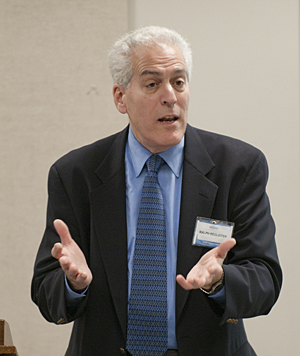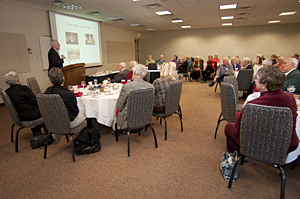ADVERTISEMENT
- Rozovsky wins prestigious NSF Early Career Award
- UD students meet alumni, experience 'closing bell' at NYSE
- Newark Police seek assistance in identifying suspects in robbery
- Rivlin says bipartisan budget action, stronger budget rules key to reversing debt
- Stink bugs shouldn't pose problem until late summer
- Gao to honor Placido Domingo in Washington performance
- Adopt-A-Highway project keeps Lewes road clean
- WVUD's Radiothon fundraiser runs April 1-10
- W.D. Snodgrass Symposium to honor Pulitzer winner
- New guide helps cancer patients manage symptoms
- UD in the News, March 25, 2011
- For the Record, March 25, 2011
- Public opinion expert discusses world views of U.S. in Global Agenda series
- Congressional delegation, dean laud Center for Community Research and Service program
- Center for Political Communication sets symposium on politics, entertainment
- Students work to raise funds, awareness of domestic violence
- Equestrian team wins regional championship in Western riding
- Markell, Harker stress importance of agriculture to Delaware's economy
- Carol A. Ammon MBA Case Competition winners announced
- Prof presents blood-clotting studies at Gordon Research Conference
- Sexual Assault Awareness Month events, programs announced
- Stay connected with Sea Grant, CEOE e-newsletter
- A message to UD regarding the tragedy in Japan
- More News >>
- March 31-May 14: REP stages Neil Simon's 'The Good Doctor'
- April 2: Newark plans annual 'wine and dine'
- April 5: Expert perspective on U.S. health care
- April 5: Comedian Ace Guillen to visit Scrounge
- April 6, May 4: School of Nursing sponsors research lecture series
- April 6-May 4: Confucius Institute presents Chinese Film Series on Wednesdays
- April 6: IPCC's Pachauri to discuss sustainable development in DENIN Dialogue Series
- April 7: 'WVUDstock' radiothon concert announced
- April 8: English Language Institute presents 'Arts in Translation'
- April 9: Green and Healthy Living Expo planned at The Bob
- April 9: Center for Political Communication to host Onion editor
- April 10: Alumni Easter Egg-stravaganza planned
- April 11: CDS session to focus on visual assistive technologies
- April 12: T.J. Stiles to speak at UDLA annual dinner
- April 15, 16: Annual UD push lawnmower tune-up scheduled
- April 15, 16: Master Players series presents iMusic 4, China Magpie
- April 15, 16: Delaware Symphony, UD chorus to perform Mahler work
- April 18: Former NFL Coach Bill Cowher featured in UD Speaks
- April 21-24: Sesame Street Live brings Elmo and friends to The Bob
- April 30: Save the date for Ag Day 2011 at UD
- April 30: Symposium to consider 'Frontiers at the Chemistry-Biology Interface'
- April 30-May 1: Relay for Life set at Delaware Field House
- May 4: Delaware Membrane Protein Symposium announced
- May 5: Northwestern University's Leon Keer to deliver Kerr lecture
- May 7: Women's volleyball team to host second annual Spring Fling
- Through May 3: SPPA announces speakers for 10th annual lecture series
- Through May 4: Global Agenda sees U.S. through others' eyes; World Bank president to speak
- Through May 4: 'Research on Race, Ethnicity, Culture' topic of series
- Through May 9: Black American Studies announces lecture series
- Through May 11: 'Challenges in Jewish Culture' lecture series announced
- Through May 11: Area Studies research featured in speaker series
- Through June 5: 'Andy Warhol: Behind the Camera' on view in Old College Gallery
- Through July 15: 'Bodyscapes' on view at Mechanical Hall Gallery
- More What's Happening >>
- UD calendar >>
- Middle States evaluation team on campus April 5
- Phipps named HR Liaison of the Quarter
- Senior wins iPad for participating in assessment study
- April 19: Procurement Services schedules information sessions
- UD Bookstore announces spring break hours
- HealthyU Wellness Program encourages employees to 'Step into Spring'
- April 8-29: Faculty roundtable series considers student engagement
- GRE is changing; learn more at April 15 info session
- April 30: UD Evening with Blue Rocks set for employees
- Morris Library to be open 24/7 during final exams
- More Campus FYI >>
2:27 p.m., Dec. 7, 2009----While the election of Barack Obama as the 44th president of the United States was touted by the media as an historic event, many communications experts believe the presidential race also evidenced a major shift in the way voters and candidates used various media to present and obtain the latest information on the candidates.
Ralph Beglieter, Rosenberg Professor of Communication, Distinguished Journalist in Residence and director of the new Center for Political Communication, discussed these changes during a presentation at the Dec. 1 luncheon meeting of the University of Delaware Association of Retired Faculty in Clayton Hall.
In his presentation, “New Frontier in Media and Election: How Digital Media Affected the 2008 Presidential Election,” Begleiter noted that while the campaign featured the first African American to be elected president and the second woman, Sarah Palin, to run for vice president, it also represented a major shift in how the news was delivered.
“Basically, you had newspapers pretty much disappear from the scene in terms of popularity,” Begleiter said. “Now, most Americans get their news from other sources.”
To emphasize the changing patterns of political communications in recent years, Beglieter showed a video clip of NBC newscaster Chet Huntley as he reported election night coverage during 1960 presidential election between the eventual winner John F. Kennedy, and his opponent, Richard M. Nixon.
“In 1960, there were only three channels to watch,” Begleiter said. “Those days are long gone. When I show this clip to students today, they think it is from some ancient era.”
While analysis and coverage of political elections as recently as 2004 featured established journalists, such as veteran political reporter Jack Germond, such commentators were overshadowed in 2008 by blogs and other Internet information venues.
“The national political conventions last year were the most widely watched since 1960, but what is interesting is that viewers didn't watch them on the traditional news networks, but on cable television programs,” Begleiter said. “When I joined CNN in 1981, there was only one cable news network. Now, there are 10 channels covering the campaigns.”
Gone also from convention coverage, Begleiter said, is the gavel-to-gavel coverage that networks provided before the advent of the Internet and cable networks.
“Today, you get about one hour of coverage for each of the four days of the political conventions, and it is shown during the hour just before the 11 p.m. news programs,” Begleiter said. “This is because political leaders have compressed the most important and interesting pieces of convention business into this hour, and they want the big viewer lead-ins that networks get during prime time entertainment specials leading up to the newscasts.”
Besides changing the way political news is both covered and viewed, the advent of cable television news networks, mobile devices and the Internet also means that while political junkies get all the news they need, this is not the case with the ordinary viewers who make up the bulk of the electorate, Begleiter said.
The Internet also has also ratcheted up the amount of unchecked information surfacing in blogs and Web sites. This change is matched, Begleiter noted, by an increasing ability of those in charge of campaigns to react almost immediately to such information.
“People and groups are not restricted as to what they can put on the Internet, and it often is not clear who these individuals are and how they got their information,” Begleiter said. “With the technology we have today, campaigns can change directions in an instant.”
In what he described as both the good news and the bad news in all of this, Begleiter said that while everyone now has the opportunity to be a publisher, with many voices being heard, there also are as many “frames” posted by uninformed, often nonprofessional individuals.
“What this also means is that there are no standards at all, and that a lot of professional journalists are out of work,” Begleiter said. “We have to find a way to establish some new standards while carrying the old standards of professionalism into campaign reporting.”
Center for Political Communication
Begleiter also discussed the UD Center for Political Communication, established recently to study and teach about the information technology revolution's effect on campaigns for public office and policy debates.
“We are starting a new mission, whose primary focus is to engage people in a variety of disciplines working together on issues such as global communication,” Begleiter said. “We are very excited about this, because we have gotten political scientists and communication faculty working together on research projects that are already under way, and we know that there are going to be a lot more to come.”
Begleiter also noted that the infusion of good ideas is expected to lead to further expansion that includes faculty from other disciplines.
“We think this is something that will engage student activity in many ways,” Begleiter said. “We also hope to build on the kind of initiative created by UD's fall public affairs lecture series” on the first year of the Obama presidency.
The series, which included appearances by experts from both sides of the political spectrum, was sponsored by the departments of Communication and Political Science and International Relations, the Office of the Provost, the College of Arts and Sciences and the School of Urban Affairs and Public Policy.
Article by Jerry Rhodes
Photos by Evan Krape




